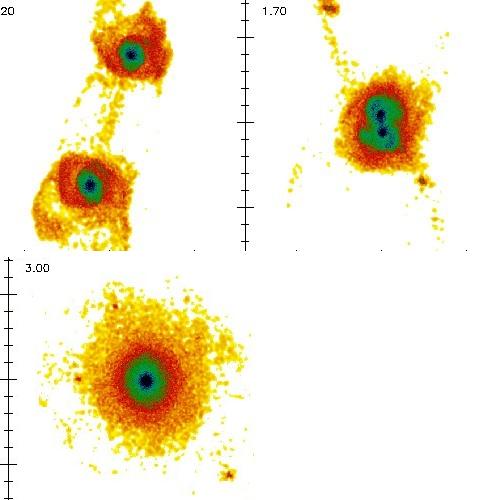Research led by an astrophysicist from the Hebrew University solves a cosmological mystery: the lost dark matter is found in galaxies! * The research will be published today (Thursday) in the prestigious journal NATURE

The agreed upon cosmological model, which serves as a basis for scientific research on the structure of the universe and its development, assumes that every luminous galaxy (consisting of a hundred billion stars similar to the sun) resides in a sphere containing a mass ten times greater or more of dark matter. The dark matter does not emit light, and its exact nature is not clear, but its amount can be measured through the gravitational force it exerts on the stars, which accelerates their movement.
The validity of the standard model was put into significant question when a group of astronomers unexpectedly reported in the journal SCIENCE on observations that in their opinion indicate the absence of dark matter in "elliptical" galaxies (galaxies with a spherical structure). The measurements showed extremely slow movements of stars at large distances from the centers of elliptical galaxies, in contradiction to the high velocities that were apparently expected due to the gravitational attraction resulting from a lot of dark matter.
The solution to the problem was achieved through a new theoretical analysis led by Professor Avishai Dekel, an astrophysicist from the Institute of Physics at the Hebrew University of Jerusalem, which will be published today, Thursday, September 29, in the prestigious journal Nature. Prof. Dekel and his colleagues make it clear in the study that these observations do not contradict the accepted picture, but are rather consistent with the presence of dark matter in large quantities in the "elliptical" galaxies as well.
According to Prof. Dekel, the lack of dark matter in elliptical galaxies was incomprehensible because, according to the evidence we have, these galaxies were formed by collisions and mergers of "spiral" galaxies (having a flat structure of stars moving in the form of a disk, such as the "Milky Way"). In spiral galaxies, the existence of dark matter is not in doubt - the high rotation speeds of the stars around the galaxy indicate its existence. "Where could the dark matter have disappeared during the mergers of spiral galaxies to form elliptical galaxies?" Dekal asks.
Dekel and his colleagues used a supercomputer to simulate the collisions of spiral galaxies, which have a lot of dark matter. The simulations show that the apparently slow speeds are actually the result of the collisions that form the elliptical galaxies. The simulations were done as part of Thomas Cox's doctoral thesis under the guidance of Professor Jules Primack at the University of California, Santa Cruz, and the analysis of the simulations was done by Prof. Deckel and his colleagues Felix Stoer and Gary Mamon at the Paris Institute of Astrophysics, where Prof. Deckel holds the Blaise Pascal International Research Chair.
Prof. Dekel explained today that "the fast movements mistakenly appear slow because only one component of the star's movement can be measured with a telescope: the movement of approaching or receding along the line of sight from the observer to the star.
Another component of the movement of the stars is the change in the place of the stars in relation to other stars in the sky, but due to the great distance of the stars, this component of the movement cannot be measured. If the stars were moving in random directions, the partial information obtained about movement along the line of sight would be sufficient to estimate the total speed of the stars. But not so if the stars move in orbits from the center of the galaxy out and back. In such a case, most of the stars that the viewer sees at large distances from the center of the galaxy move across the plane of the sky - the stars do not approach the viewer or move away from him, so the viewer does not notice their real movements."
The important discovery of Prof. Dekel and his colleagues, based on the new simulations, is that the stars formed as a result of mergers of spiral galaxies do not move in random orbits but tend to move in elongated orbits. The simulations showed that when the colliding galaxies pass one another, the strong gravitational forces tear the stars from their original orbits and throw some of them from the center out along elongated orbits.
"Our conclusion is that the apparently surprising measurements are in fact consistent with the agreed upon cosmological model that assumes the existence of dark matter. This removed a major problem that troubled the cosmologists," Dekel concludes. "The data obtained from the observations confirm the theory that there is dark matter also in elliptical galaxies and that these galaxies were formed by mergers of spiral galaxies. This research allows us to better understand the formation processes of galaxies, and in particular the important role of collisions between galaxies in the development of structures in the universe."

One response
Greetings
I'm interested in knowing what will happen to the dark matter in the universe in a large number of
billions of years. I know from watching science programs on the Discovery Science channel,
that the dark matter that melted about twenty-seven percent of the total mass in the universe consists of strips on the surface of which galaxies form. My question is whether
These strips will tend to stretch, and if it can be measured, and whether the expansion
The universe will cause the dark matter a fate similar to the fate of all the matter in the universe, i.e. total tearing followed by a dark and empty universe, as will be discovered.
Thank you